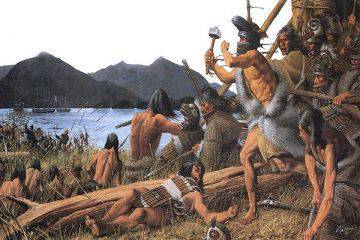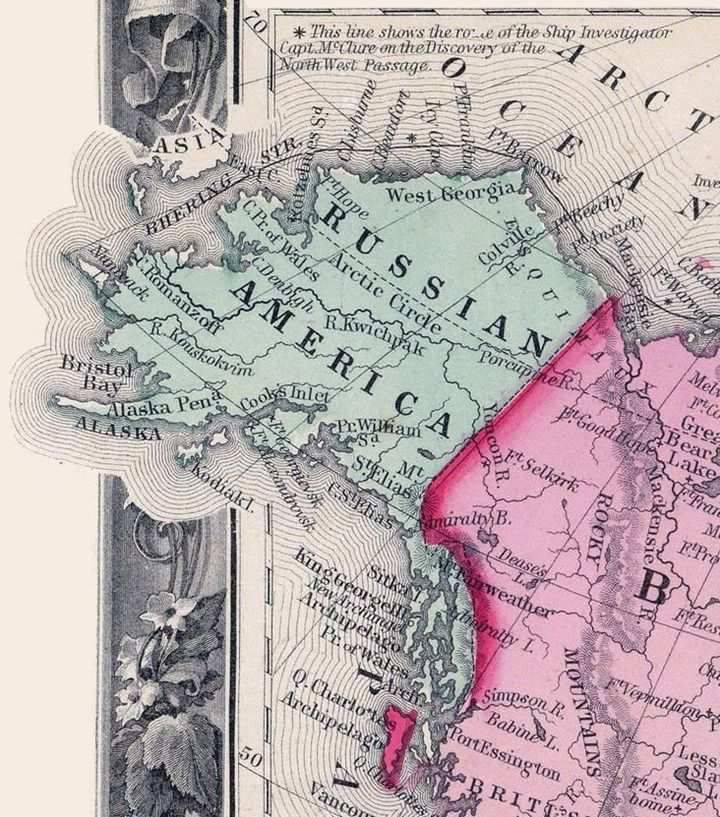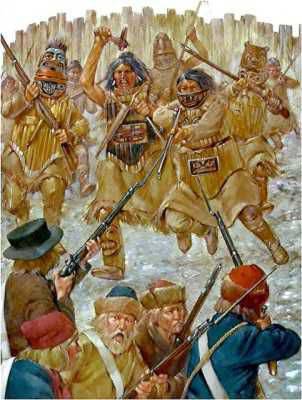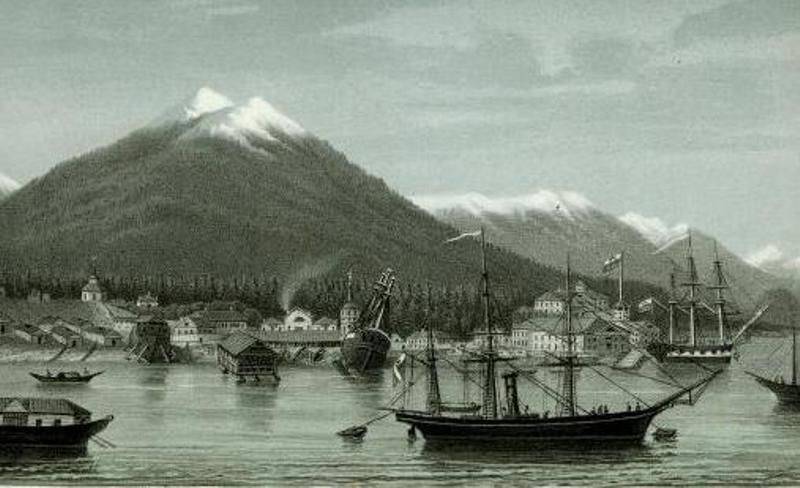Russian-Indian War in Alaska 1802 - 1805.
 The conquest of Alaska by the Russian colonists began at the end of the 18th century. Moving south along the mainland coast of Alaska in search of richer fishing grounds, the Russian parties of sea animal hunters were gradually approaching the territory inhabited by Tlingitas, one of the most powerful and formidable tribes of the Northwest coast. The Russians called them Kolosha (Kolyuzha). This name comes from the custom of Tlingit women to insert a wooden plank - a calico into the incision on the lower lip, which is why the lip was stretched and sagged. "Evil of the most predatory animals", "people are murderous and evil", "bloodthirsty barbarians" - Russian pioneers spoke of Tlingits in such terms. And for that they had their own reasons.
The conquest of Alaska by the Russian colonists began at the end of the 18th century. Moving south along the mainland coast of Alaska in search of richer fishing grounds, the Russian parties of sea animal hunters were gradually approaching the territory inhabited by Tlingitas, one of the most powerful and formidable tribes of the Northwest coast. The Russians called them Kolosha (Kolyuzha). This name comes from the custom of Tlingit women to insert a wooden plank - a calico into the incision on the lower lip, which is why the lip was stretched and sagged. "Evil of the most predatory animals", "people are murderous and evil", "bloodthirsty barbarians" - Russian pioneers spoke of Tlingits in such terms. And for that they had their own reasons.By the end of the XVIII century. Tlingits occupied the coast of southeastern Alaska from the Portland Canal Bay in the south to Yakutat Bay in the north, as well as the adjacent islands of the Alexander Archipelago.
The Tlingit country was divided into territorial units - Kuans (Sitka, Yakutat, Khuna, Khutsnuva, Akoy, Stikin, Chilkat, etc.). In each of them there could be several large winter villages where representatives of different clans (clans, Sibs) lived, belonging to two large tribal phratries - Wolf / Eagle and Crow. These clans - Kiksadi, Kagvantan, Deshitan, Tluknahadi, Tekuedi, Nanyayi, etc. - often quarreled among themselves. It was the clan and clan ties that were most significant and strong in Tlingit society.

The first clashes between Russians and Tlingits date back to the 1741 year, later there were also minor clashes with the use of weapons.
In 1792, an armed conflict occurred on the island of Hinchinbrook with an uncertain outcome: the head of the industrialist party and the future ruler of Alaska Alexander Baranov almost died, the Indians retreated, but the Russians did not dare to gain a foothold on the island and also sailed to Kodiak Island. The Tlingit warriors were dressed in wicker wooden sacks, moose coats and animal-like helmets (apparently from animal skulls). Armed Indians were mainly cold and throwing weapons.
If during the attack on the party of A. A. Baranov in 1792, the Tlingits did not use firearms, then already in 1794 they had a lot of guns, as well as decent stocks of ammunition and gunpowder.
Peace Treaty with the Indians of Sitka Island
The Russians in 1795 appear on Sitka Island, which was owned by the Tlingit clan Kixadi. Closer contacts began with 1798.
After several minor clashes with small Kiksadi detachments headed by young military leader Katlean, Alexander Andreyevich Baranov makes an agreement with the leader of the Kiksadi tribe, Scoutlelt, to acquire land for building a trading post.
Scoutlelt was baptized, and his name became Michael. Baranov was his chair father. Scoutlelt and Baranov agreed on the assignment of the Kixadis to the Russian part of the land on the shore and the construction of a small trading post at the mouth of the Starrigavan river.
The union between the Russians and the Kiksadi was beneficial to both parties. The Russians patronized the Indians and helped them defend against other warring tribes.
15 July 1799, the Russians began the construction of the fort "St. Michael the Archangel", now this place is called Old Sitka.
In the meantime, the Qiksadis and Deshitans made an armistice — the feud between the Indian clans ceased.
The danger for kiksadi disappeared. Too close connection with the Russians is now becoming too burdensome. Both the Kiksadis and the Russians felt this very soon.
The Tlingit from other clans who visited Sitka after the cessation of hostilities there, mocked its inhabitants and "boasted of their freedom." The largest spat occurred on Easter, however, thanks to the decisive actions of A.A. Baranov, bloodshed was avoided. However, April 22 1800 A.A. Baranov left for Kodiak, leaving the commanding officer V.G. Medvednikov.
Despite the fact that the Tlingit had a rich experience of communication with Europeans, the relationship between Russian settlers and Aboriginal people became increasingly aggravated, which eventually led to a protracted bloody war. However, such a result was by no means just a ridiculous accident or a consequence of the intrigues of insidious foreigners, as these events were not generated by the only natural bloodthirstiness of "ferocious Kolos." On the warpath of war, the Tlingit kuans brought out other, deeper reasons.
Background of war
Russian and Anglo-American merchants had one goal in the local waters, one main source of profit - fur, rye fur. But the means to achieve this was different. The Russians themselves were extracting precious furs, sending parties of Aleuts after them and establishing permanent fortified settlements in the areas of the fishery. Buying skins from the Indians played a secondary role.
Oppositely, due to the specifics of their position, British and American (Boston) merchants acted. They periodically came on their ships to the shores of the Tlingit country, conducted active trade, bought furs and left, leaving the Indians instead of cloth, weapons, ammunition, and alcohol.

The Russian-American company could offer virtually nothing of these goods, so valued by them, to the Tlingit. The Russian ban on the trade in firearms, pushed the Tlingit to even closer ties with the Bostonians. For this trade, the volume of which was constantly increasing, the Indians needed more and more furs. However, the Russians, by their activity, prevented the Tlingit from trading with the Anglo-Saxons.
The active fishing of the sea rye, which led the Russian party, was the cause of the impoverishment of the natural resources of the region, depriving the Indians of their main product in relations with the Anglo-Americans. All this could not but affect the relations of the Indians to the Russian colonists. The Anglo-Saxons actively stirred up their hostility.
Each year, about fifteen foreign vessels were taken out of the possessions of PAK 10-15 thousands of sea otters, which was equal to four years of Russian fishing. Strengthening the Russian presence threatened them with deprivation of profits.
Thus, the predatory fishing of the sea beast, which the Russian-American company launched, undermined the economic well-being of the Tlingit, depriving them of their main goods in profitable trade with the Anglo-American maritime traders, whose inflammatory actions served as a kind of catalyst that accelerated the unfolding of the imminent military conflict. Reckless and rude actions of the Russian industrial enterprises were the impetus for the unification of the Tlingit in the struggle to expel the RAC from their territories.
In the winter of 1802, in Khutsnuvu-Kuan (Father Admiralty), a great council of leaders was held, at which it was decided to start a war against the Russians. The council developed a plan of military operations. It was planned with the onset of spring to gather warriors in Khutsnuva and, after waiting for the fishing party to leave Sitka, attack the fort. The party was scheduled to trap in the Strait of the Dead.
The hostilities began in May 1802 with an attack at the mouth of the Alsek River on the Yakutat fishing party of I.A. Kuskova. The party consisted of 900 native hunters and more than a dozen Russian industrial. The Indian attack after several days of gunfire was successfully repulsed. The Tlingit, seeing the complete failure of their warlike plans, went to the negotiations and concluded a truce.
Tlingit Uprising - the destruction of the Mikhailovsky Fort and the fishing parties of the Russians
After the fishing party of Ivan Urbanov (about 190 Aleuts) left the Mikhailovsky Fort, 26 Russians left on Sitka, six “Englishmen” (American sailors in the service of Russians), 20-30 Kadiaks and about 50 women and children. A small gang under the command of Aleksey Evglevsky and Aleksey Baturin, June 10, went on a hunt to the “distant Sioux stone”. Other inhabitants of the settlement continued to blithely do their daily activities.
The Indians attacked simultaneously from two sides - from the forest and from the side of the bay, having sailed in combat canoes. This campaign was led by the military leader of the Kiksadi, Scoutelt's nephew, and the young leader, Catlian. An armed crowd of Tlingits, numbering about 600 people under the command of the leader of the Sitkins, Scoutletta, surrounded the barracks and opened strong gunfire on the windows. A huge cry from the cape of the bay flotilla fighting canoes on which there were at least 1000 Native American soldiers who immediately joined the Sitkines. Soon the roof of the barracks flared. The Russians tried to shoot back, but could not resist the overwhelming superiority of the attackers: the doors of the barracks were knocked out and, despite the direct fire of the gun standing inside, the Tlingits managed to get inside, kill all the defenders and plunder the furs stored in the barracks
There are various versions of the participation of the Anglo-Saxons in the outbreak of war.
The East Indian captain Barber landed six sailors in 1802 on Sitka Island for allegedly rioting on a ship. They were taken to work in the Russian city.
Having bribed the Indian leaders with weapons, rum and trinkets, during the long winter camp in the Tlingit villages, offering gifts to them if they were driving the Russians from their island and threatening not to sell guns and whiskey, Barber played on the ambition of the young military leader Katleana. The gates of the fort were opened from the inside by American sailors. So, naturally, without warning and explanation, the Indians attacked the fortress. All defenders, including women and children, were killed.
According to another version, the real instigator of the Indians should be considered not the Englishman Barber, but the American Cunningham. He, unlike Barber and the sailors, turned out to be on Sitka clearly not by accident. There is a version that he was devoted to the Tlingit plans, and even participated directly in their development.
The fact that the aliens will be declared responsible for the Sitka catastrophe was originally predetermined. But the reasons that the main culprit was then recognized by the Englishman Barber lie, probably in the uncertainty in which Russian foreign policy was in those years.
The fortress was completely destroyed, and the entire population exterminated. There is still nothing built. Losses for Russian America were significant, for two years Baranov was gathering strength to return to Sitka.
The news of the defeat of the fortress Baranov brought the English captain Barber. On the island of Kodiak, he put 20 guns from the board of his ship - "Unicorn". But, being afraid to mess with Baranov, went to the Sandwich Islands - to trade with the Hawaiians the good that was stolen in Sitka.
A day later, the Indians destroyed almost the entire small party of Vasily Kochesov, who was returning to the fortress from the sea lion's fishery.
Tlingit fueled a special hatred of Vasily Kochesov, the famous hunter, known among the Indians and Russians, as an unsurpassed marksman. The Tlingits called him Gidak, which probably comes from the Tlingit name of the Aleuts, whose blood flowed in the veins of Kochesov - giyak-kwaan (the mother of the hunter was from the Fox Ridge Islands). Having finally gotten the hated archer into their own hands, the Indians tried to make his death, like the death of his comrade, as painful as possible. According to KT Khlebnikov, “the barbarians did not suddenly, but temporarily cut off their nose, ears and other members of their body, stuffed their mouths with them, and maliciously mocked the torments of sufferers. Kochesov ... could not bear the pain for a long time and was happy the cessation of life, but the unfortunate Eglevsky languished for more than a day in terrible agony "
In the same 1802 year: the Indians of Ivan Urbanov (90 kayaks) in the Frederick Strait were attacked by the Indians and attacked on the night from 19 to 20 in June. Hiding in ambush, the warriors of Kuan Kake-Kuyu did not betray their presence and, as KT Khlebnikov wrote, “the party leaders did not notice any troubles or cause for displeasure ... But this silence and silence were forerunners of a severe thunderstorm.” The Indians attacked partovschiki at night and "almost to death they destroyed them with bullets and daggers." 165 Kadiaks perished in the massacre, and it was no less severe a blow to the Russian colonization than the destruction of the Mikhailovsky Fortress.
Russian return to Sitka
Then came 1804 year - the year of the return of the Russians to Sitka. Baranov learned that the first Russian round-the-world expedition set sail from Kronstadt, and was looking forward to the arrival of the Neva in Russian America, while at the same time building a whole fleet of ships.
In the summer of 1804, the ruler of the Russian possessions in America, A.A. Baranov traveled to the island with 150 industrialists and 500 Aleuts on their canoes and with the ships Ermak, Alexander, Ekaterina and Rostislav.
A.A. Baranov ordered the Russian ships to be located opposite the village. For a whole month, he negotiated with the leaders about the extradition of several prisoners and the renewal of the treaty, but all was unsuccessful. The Indians moved from their old village to a new settlement at the mouth of the Indian River.
Began hostilities. In early October, the brigade Neva, commanded by Lisyansky, joined the Baranov flotilla.
After stubborn and prolonged resistance from kolosh, parliamentarians appeared. After the negotiations, the whole tribe was gone.
8 October 1804 was a Russian flag hoisted over an Indian settlement.
Novoarkhangelsk - the capital of Russian America
Baranov occupied the empty village and destroyed it. A new fortress was laid here - the future capital of Russian America - Novo-Arkhangelsk. On the shore of the bay, where the old Indian village stood, on a dais, a fortification was built, and then the house of the Ruler, which the Indians called Baranova Castle.
Only in the autumn of 1805 of the year, an agreement between Baranov and Scoutlelt was re-concluded. The gifts included a bronze double-headed eagle, the Cap of the World, made by the Russians on the model of Tlingit's ceremonial hats, and a blue robe with ermine. But for a long time the Russians and the Aleuts were afraid to go deep into the impassable rainforests of Sitka, this could cost them their lives.

Since August Novoarkhangelsk 1808 became the main city of the Russian-American company and the administrative center of the Russian possessions in Alaska and remained it until 1867, when Alaska was sold to the United States.
In Novoarkhangelsk there was a wooden fortress, a shipyard, warehouses, barracks, apartment houses. Here lived 222 Russian and over 1 thousand natives.
The fall of the Russian fort Yakut
20 August 1805, the Ejaki warriors of the Tlahaik-Tekuedi (Tlukhedi) clan, led by Tanuh and Lushvak, and their Tlingit allies from the Kuashkuan clan burned Yakut and killed the Russians who remained there. Of the total population of the Russian colony in Yakutat in 1805, according to official data, 14 Russians died “and there are still many islanders with them,” that is, Allied Aleuts. The main part of the party, together with Demyanenkov, was sunk into the sea by a stormy storm. Then about 250 people died. The fall of Yakutat and the death of Demyanenkov’s party were another heavy blow to the Russian colonies. An important economic and strategic base on the coast of America was lost.
Thus, the armed actions of the Tlingit and Ejac in 1802-1805. significantly weakened the potential of cancer. Direct financial damage reached, apparently, at least half a million rubles. All this for several years stopped the advance of the Russians in a southerly direction along the northwestern coast of America. The Indian threat and further hampered the forces of the RAC in the area of arch. Alexander did not allow to proceed to the systematic colonization of Southeast Alaska.
Confrontation relapses
So, 4 February 1851, an Indian military detachment from r. Koyukuk attacked a village of Indians who lived with a Russian loner (trading post) Nulato on the Yukon. Attack suffered itself loner. However, the attackers were repulsed with damage. The Russians also suffered losses: the head of the trading center Vasily Deryabin died and a company employee (Aleut) and English lieutenant Bernard, who arrived in Nulato from the British military sloop "Enterprise" to search for the missing members of Franklin's third polar expedition, were fatally injured. In the same winter, the Tlingit (Sitka's Koloshi) staged several quarrels and fights with Russians in the market and in the forest near Novoarkhangelsk. In response to these provocations, the main ruler, N. Ya. Rosenberg, declared to the Indians that if the unrest continued, he would order to close the Koloshen market altogether and interrupt any trade with them. The sitkin’s reaction to this ultimatum was unprecedented: the next morning they attempted to capture Novoarkhangelsk. Part of them, armed with guns, sat down in the bushes near the fortress wall; the other, having put the stairs prepared in advance to a wooden tower with cannons, the so-called “Koloshensky battery”, almost captured it. Fortunately for the Russians, the sentries were alert and raised the alarm on time. The armed detachment arriving to the rescue dropped down the three Indians who had already climbed onto the battery, and stopped the rest.
In November, 1855, another incident occurred when several natives captured Andreevsky alone in the lower Yukon. At that time, its manager was here - Kharkov tradesman Alexander Shcherbakov and two Finnish workers who served in the CANCER. As a result of a surprise attack, the canoe-driver Shcherbakov and one worker were killed, and the loner was plundered. Cancer survivor Lavrentiy Keryanin managed to escape and safely get to the Mikhailovsky Redoubt. Immediately the punitive expedition was outfitted, which tracked down the natives who had been hiding in the tundra, who had ravaged Andreevsky alone. They sat down in the drum (an Eskimo half-earth man) and refused to give up. The Russians were forced to open fire. As a result of the shooting, five natives were killed, and one managed to escape.
Information